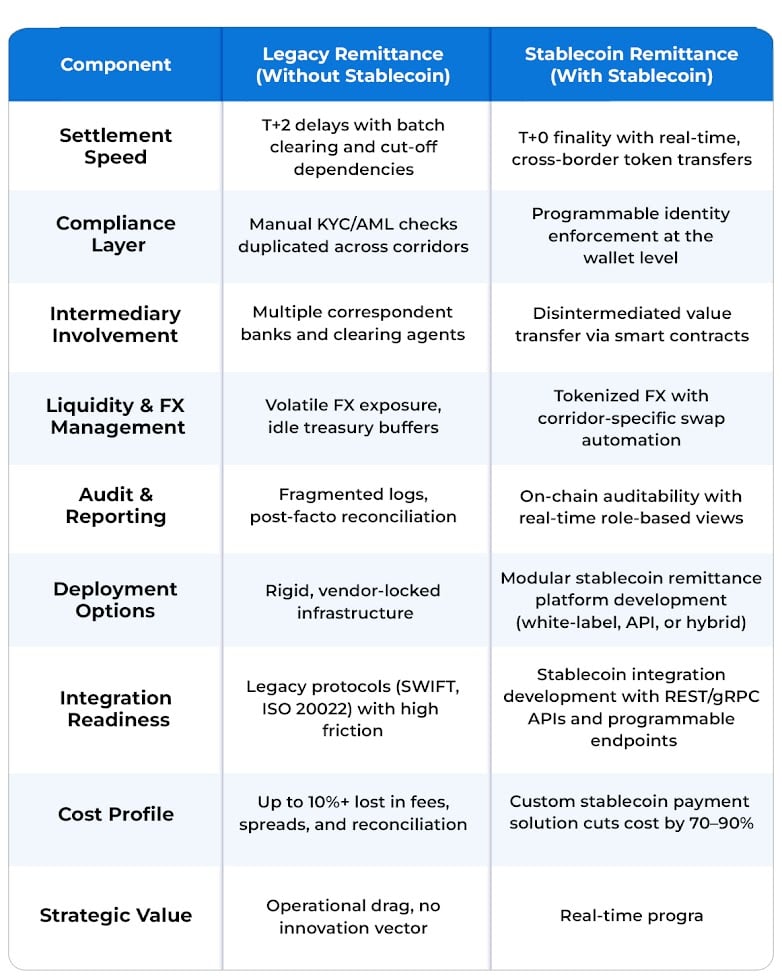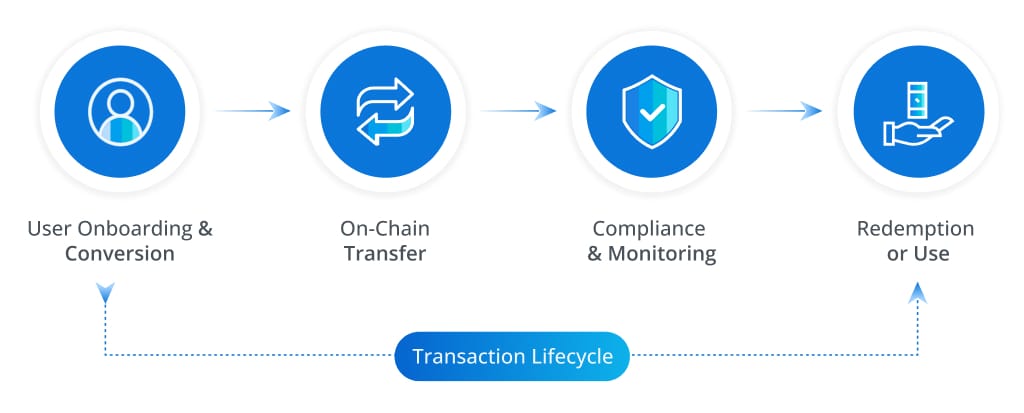views
Behind every international payment is a hidden cost that bleeds institutions dry: liquidity drag. Banks and fintechs pre-fund accounts, overestimate FX needs, and park working capital in treasuries to navigate delayed settlements and volatile currency corridors. The result? Frozen funds, costly buffers, and missed opportunities in faster-moving markets.
Traditional remittance systems force institutions to build around their constraints instead of enabling growth. But that changes with stablecoin remittance platforms. These systems enable you to tokenize FX, automate corridor-specific swaps, and transfer value in real-time, without tying up working capital. Every payout, every transfer, every redemption becomes an orchestrated, smart-contract-driven event.

In the sections ahead, we’ll explore how programmable liquidity and tokenized settlement architecture not only lower costs but also unlock financial agility at scale.
What is Stablecoin Remittance?
Stablecoin remittance redefines value transfer across borders by replacing legacy correspondent rails with programmable, tokenized infrastructure. It enables institutions to move fiat-equivalent assets on-chain with T+0 finality, bypassing traditional friction points like reconciliation lags, FX opacity, and multi-jurisdictional compliance hurdles.
“Traditional finance settles in T+2 or T+1 cycles (where T is the transaction date and the +1 or +2 indicates business days to settlement), creating delays, liquidity constraints, and risk. Today, we stand at the dawn of the T+0 era—real-time & cross‑border settlement.”
This shift reduces costs, enhances liquidity orchestration, and unlocks institutional-grade transparency without compromising control. With APIs built for integration into core systems, stablecoin rails offer real-time execution and auditability that legacy systems can’t match. Designed for financial-grade deployment, these remittance layers provide a secure, compliance-embedded alternative to outdated wire protocols. The result? A remittance network engineered for modern finance. It replaces fragmented processes with programmable logic, offering speed, compliance, and visibility by default. Institutions no longer trade efficiency for control; they get both.
Stablecoin Remittance: A Solution to Legacy Financial Inefficiencies
Legacy remittance systems are slow, expensive, and overloaded with intermediaries.
This comparison outlines how stablecoin infrastructure transforms core components, settlement, compliance, FX, and beyond.

Stablecoin remittance platforms offer speed, control, and transparency that legacy systems can’t match. The shift is no longer optional. It’s overdue. What Web2 struggled to deliver, Web3 now hardcoded into the rails.
The Core Benefits of a Stablecoin Remittance Platform
Legacy systems can’t keep pace with global settlement demands. A stablecoin remittance platform delivers the speed, control, and compliance institutions now require.
- T+0 Global Settlements: Transfers finalize in seconds across corridors, eliminating cutoffs and batching limitations found in legacy payment systems. The stablecoin remittance platform’s real-time finality strengthens capital efficiency and improves customer experience at scale.
- Embedded Compliance Logic: KYC, AML, and sanctions checks are enforced live through smart contracts, reducing overhead and ensuring jurisdictional adherence. There are no post-facto audits; compliance is coded into each transaction flow by design. Institutions operate with less regulatory risk and faster onboarding cycles.
- Corridor-Based FX Management: Institutions use tokenized FX buffers for real-time currency swaps, avoiding volatility and automating rate precision at every layer. This level of control is engineered into the stablecoin remittance platform itself, not layered on afterthought.
- Reduced Operational Drag: Disintermediation of traditional rails slashes fees and friction. Institutions lower costs without sacrificing security or user experience. No SWIFT, no intermediaries, just atomic movement of value between verified wallets.
- Modular Integration Design: APIs support smooth embedding into banking stacks, CRMs, or ERPs. Institutions can deploy what they need, nothing extra. Integration doesn’t require re-architecture, only orchestration. This stablecoin integration development ensures faster time-to-value and controlled system extension.
- Smart Wallet Governance: Role-based wallets enforce transaction limits and logic control, bringing deterministic governance to every institutional transaction. Admin roles, circuit breakers, and permission logic are fully programmable. Governance becomes code, not just policy.
- Real-Time Auditability: Every mint, swap, and payout is recorded immutably. Internal teams and regulators access transparent logs without delays. Dashboards show transaction lineage with exportable, regulator-facing formats. A stablecoin remittance platform ensures this transparency.
- Fast Corridor Activation: Predefined compliance layers and liquidity tools let banks launch remittance corridors in weeks, not operational quarters. Smart routing logic and tokenized FX make corridor expansion frictionless. New markets can be turned on without overhauling core systems.
- Customizable Infrastructure Stack: Build stablecoin payment systems tuned to internal logic. Whether launching APIs or full-stack Rails, control stays institutional. Custom stablecoin platform development ensures your infrastructure scales across use cases and jurisdictions.
This is more than optimization; it’s a shift in financial architecture. Stablecoin remittance platform development enables institutions to scale with precision and confidence. But transformation isn’t just about faster rails; it’s about re-architecting how value moves, settles, and stays compliant across borders.
From Onboarding to Payout: The Complete Transaction Flow
Legacy remittance infrastructure is riddled with intermediaries, delayed settlements, and fragmented compliance. Institutions need more than surface-level improvements; they need programmable, real-time financial flows. That’s where a modern remittance transaction lifecycle, powered by stablecoins, creates operational clarity.

- User Onboarding & Conversion: Institutional users are onboard via integrated KYC portals. Fiat is converted into tokenized value, ready for compliant, on-chain movement.
- On-Chain Transfer: Using a permissioned ledger, funds are transferred in seconds with full traceability and smart contract automation. This streamlines movement across jurisdictions.
- Compliance & Monitoring: Every transaction is governed by live policy enforcement. KYC, AML, velocity limits, and source-of-funds checks are executed automatically.
- Redemption or Use: Tokens can be redeemed into fiat or routed for business use, unlocking liquidity efficiency across payout networks and internal operations.
The result? A deterministic system designed for scale and trust. A stablecoin remittance platform eliminates manual reconciliation, improves auditability, and accelerates capital velocity. Through smart routing and automation, stablecoin remittance platform development reshapes global transfers for modern financial institutions. But delivering this level of performance requires more than just the right tools demands a deliberate build process.
What Are the Key Steps in Developing a Stablecoin Remittance Platform?
Building a stablecoin remittance platform requires more than utility. It requires precision, control, and code-backed compliance for global institutions.
- Identify Strategic Corridors: Choose corridors with fragmented liquidity and legacy friction. This step forms the strategic foundation for stablecoin remittance and institutional FX automation.
- Deploy Fiat-Backed Stablecoins: Use custodial partnerships to mint fully reserved stablecoins. These tokens power the stablecoin remittance platform while anchoring trust in transaction settlement.
- Embed On-Chain Compliance: Program KYC, AML, and blacklist logic into transaction flow. Stablecoin integration development must encode compliance as a default, not an afterthought.
- Construct Role-Based Wallets: Design programmable wallets with approval tiers and transaction caps. These form the backbone of any custom stablecoin payment solution serving regulated markets.
- Automate FX Conversion Logic: Pre-fund corridor-specific pools and apply smart spread algorithms. This ensures accuracy in stablecoin platform development across volatile currency pairs.



Comments
0 comment